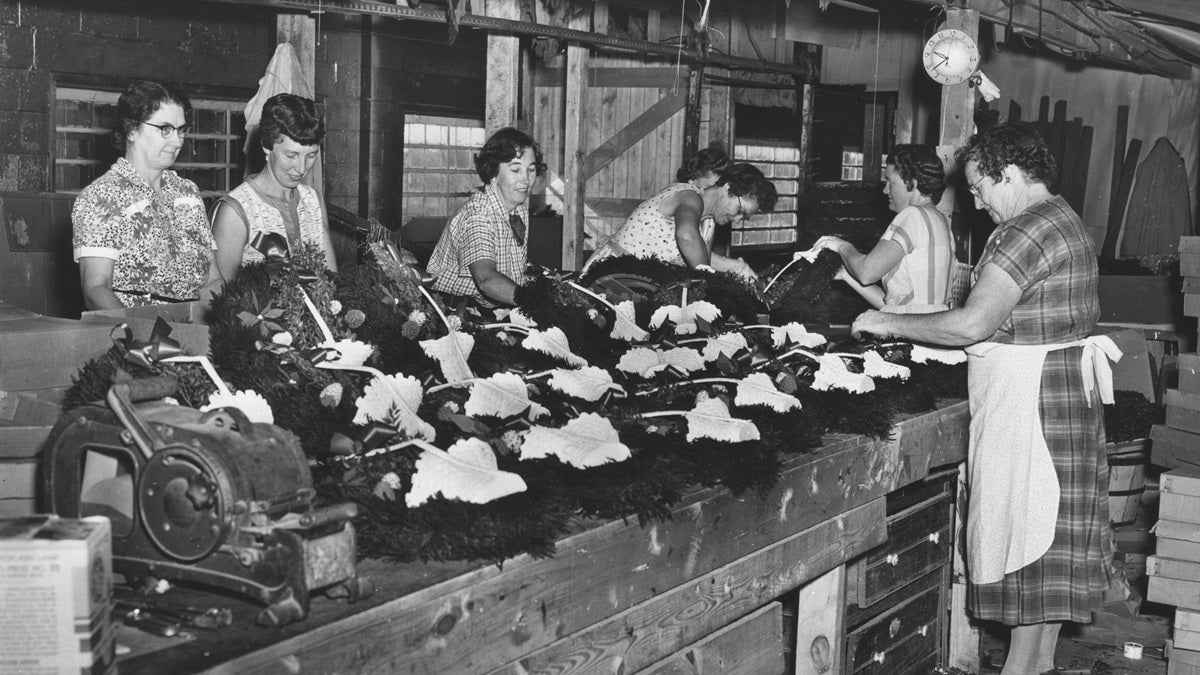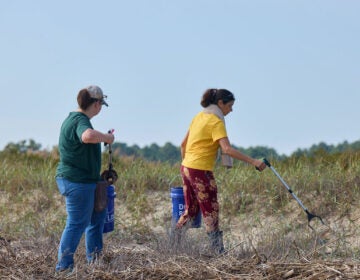Delaware’s history as ‘Holly Capital of the World’
Listen
Workers build holly wreaths for sale. (photo courtesy Delaware Public Archives)
From holly to hops, exports from one southern Delaware town have kept the holiday season cheery for decades.
A small, historic Sussex County town that looks fairly quaint in 2015, Milton, Delaware was once an economic powerhouse, especially during the holidays. While holly may take a backseat to mistletoe and poinsettias these days, holly wreaths were once big business for this southern Delaware town.
In the early 1900s, wreaths produced in Milton from locally grown holly were shipped around the region and beyond. Trains transporting fresh holly wreaths traveled from Sussex County to homes and major department stores in Philadelphia, New York, and elsewhere.
Milton’s Mike Wajda is one of the few people remaining in the town who still make holly wreaths by hand, with the limited supply of local holly trees still left. Naturally plentiful holly trees in the area in the early 1900s helped birth a big industry for local farmers after the harvest season.
“It’s very prickly so you’ve got to be very very careful,” Wajda said on a tour of his secret holly grove.
Wajda follows in the footstep of Milton’s former holly wreath king: farmer Charles Jones. “He made wreaths for Radio City Music Hall,” Wajda said. “John Wanamaker’s was a famous department store in Philadelphia, and also in Wilmington. He did wreaths for them.”
The holly wreath business stems from the need for farmers to supplement their income after the harvest season. “By the early 20th century, Milton – and actually a lot of communities similar to Milton, with similar histories and backgrounds – were starved economically,” said former Delaware State Archivist Russ McCabe. “So people needed to be creative.”
The holly business grew so big that the state legislature recognized the holly tree as the state tree. It was a booming time for seasonal greens, McCabe said. “Particularly in the cities for holly wreaths, Christmas trees, things of that nature.”
But the popularity of the wreaths left people wanting a more permanent way to display them. “The thing that really ended the industry was the advent of plastic,” McCabe said. “Let’s face it, you can get a plastic wreath and put it in the attic and it looks the same next year as it did this year. You can’t do that with the real thing.”
Combine the growth of plastic wreaths with development that depleted much of Milton’s holly groves and the wreath making industry wilted. But in his friend’s secret holly grove, Mike Wajda keeps the legacy alive. “There’s too many artificial things out there, but this is the real thing.”
These days, Milton is much better known as the home of Dogfish Head Beer, which like holly, is also exported far and wide. “It’s our beer. We like to brag on it,” McCabe said. “In a town that was once known for its strong temperance movement, Dogfish Head has completely turned things around, and done it in a very positive way.”
Milton’s holly history is celebrated every year in December with the Holly Festival. Festival activities include a holly wreath-making demonstration put on by the Milton Historical Society Museum.
WHYY is your source for fact-based, in-depth journalism and information. As a nonprofit organization, we rely on financial support from readers like you. Please give today.





